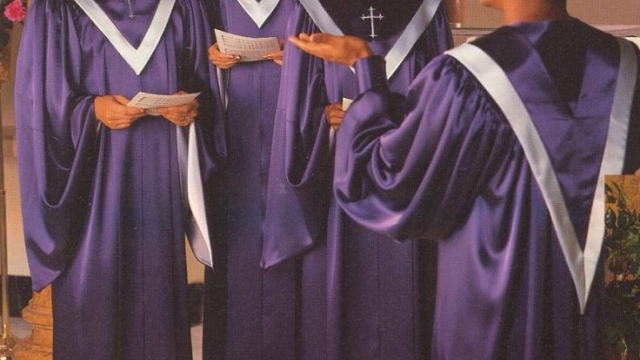
Nestled within the world of music and spirituality lies a captivating element that adds an aura of grace and unity to every performance – the choir robe. These beautifully crafted garments play an integral role in the harmonious elegance exhibited by choirs across the globe. Steeped in tradition and adorned with symbolism, choir robes not only serve as a visual spectacle but also convey a deeper story that unravels with each melodious note sung.
At first glance, one might mistake these regal attire pieces as mere costumes, but they hold profound significance within the choral community. Choir robes have long served as a unifying element, creating a sense of equality among the voices that fill our hearts with their ethereal melodies. Regardless of background or individual style, once adorned in these robes, a unity emerges that transcends personal differences and elevates the collective spirit of the choir to astonishing heights.
Histories intertwined with the advent of choral music reveal the evolution of this timeless tradition. From the early days of religious chants echoing through ancient halls to the grand performances of modern choirs gracing prestigious concert stages, choir robes have maintained their enchanting presence. Interestingly, their designs have transformed over time, reflecting both the artistic and practical sensibilities of each era. However, the essence of the choir robe remains steadfast – a visual testament to the dedication, unity, and passion shared by those who don this emblematic garment.
The History of Choir Robes
The tradition of wearing choir robes can be traced back to ancient times. In early Christian churches, choir members would often wear simple liturgical garments to signify their role in the sacred music. These robes were typically made of plain linen or wool, embodying a sense of humility and devotion.
As the centuries passed, choir robes evolved both in style and significance. During the medieval period, elaborate robes adorned with intricate embroidery and decorative features became more prominent. These ornate garments reflected the status and importance of the choirs within the church hierarchy.
In the Renaissance era, choir robes took on a more uniform appearance. The need for standardized attire arose from the desire to create a sense of unity and harmony among the choir members. The robes became a symbol of collective identity and a visual representation of the choir’s purpose, which was to enhance the spiritual experience through the power of song.
Throughout history, choir robes have remained a steadfast tradition, adapting to the changing times while preserving their inherent elegance. Today, modern choir robes are often tailored to fit each individual member, ensuring both comfort and style. The colors and design of the robes vary depending on the denomination or musical ensemble, adding further depth to the story of choir robes.
The history of choir robes is a testament to the enduring power of music and the importance of unity in worship. These garments, woven with tradition and tale, continue to enhance the visual aesthetics of choral performances while honoring the legacy of those who came before.
Symbolism and Meaning of Choir Robes
Choir robes, with their rich history and captivating allure, embody a deeper symbolism that goes beyond their aesthetic elegance. These robes serve as a visual representation of unity and harmony among the choir members, as they stand together in musical unison.
The color of the robes often holds significant meaning. White robes, for instance, symbolize purity and truth, reflecting the choir’s dedication to expressing the beauty of their voices in unison. Black robes, on the other hand, convey an air of formality and reverence, adding a sense of solemnity to their performances.
The design elements of choir robes also contribute to their symbolic essence. The flowing fabric and graceful drapery evoke a sense of spirituality and grace, aligning perfectly with the choir’s purpose of uplifting the congregation through their sacred music. Additionally, the subtle choir insignia or embroidered symbols on the robes can further reflect the choir’s identity and legacy.
Beyond their visual appeal, choir robes serve a practical purpose as well. They provide a sense of equality amongst the choir members by masking individual differences in attire and allowing the focus to remain solely on the collective musical experience. As the choir members wear their robes, they become part of a greater whole, accentuating the notion of unity and cohesion.
In essence, choir robes transcend their mere fabric and become powerful symbols of harmony and devotion. They amplify the choir’s collective voice, both visually and emotionally, and remind us of the transformative power of music when shared in unison.
Evolution of Choir Robes in Modern Times
Choir robes have evolved significantly in modern times, embodying both tradition and contemporary design. These elegant garments have undergone transformations that reflect the changing styles and sensibilities of the modern world.
Initially, choir robes were simple and modest in design. They were predominantly black or dark in color, symbolizing humility and reverence. The attire was often loose-fitting and made from heavy fabrics like wool or velvet, providing warmth and comfort during long hours of service. However, as times changed, so did the aesthetics of choir robes.
With the advent of the Renaissance, choir robes began to take on a more ornate and decorative style. Intricate detailing, such as embroidery and lacework, became common, adding a touch of grandeur to the robes. Colors other than black started to make an appearance, with rich hues like deep reds and royal blues becoming popular choices among choirs.
In recent years, choir robes have embraced a more contemporary and inclusive approach. Designs have become more diverse, catering to different body types and personal preferences. Fabrics have also evolved, with lightweight and breathable materials replacing the heavy fabrics of the past. As a result, choir members now enjoy greater ease of movement and comfort while performing.
The evolution of choir robes in modern times reflects the balance between honoring tradition and embracing new aesthetics. These robes continue to be a symbol of unity, grace, and harmony within the choral community, capturing the essence of the enchanting story behind choir robes.


